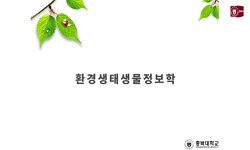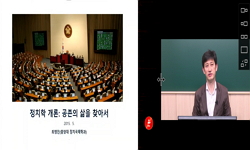본 연구에서는 '국가해양생태계종합조사' 결과를 활용하여 "암반 조하대에 서식하는 연체동물의 군집구조가 먹이자원의 종류와 양에 따라 섭식형(feeding type)별로 차이를 보일 수 있는지?"를 ...
http://chineseinput.net/에서 pinyin(병음)방식으로 중국어를 변환할 수 있습니다.
변환된 중국어를 복사하여 사용하시면 됩니다.
- 中文 을 입력하시려면 zhongwen을 입력하시고 space를누르시면됩니다.
- 北京 을 입력하시려면 beijing을 입력하시고 space를 누르시면 됩니다.

먹이생물의 종류와 양이 암반 조하대 저서동물(연체동물) 군집구조 결정요소가 될 수 있는가? = Does the Availability of Various Types and Quantity of Food Limit the Community Structure of the Benthos (Mollusks) Inhabiting in the Hard-bottom Subtidal Area?
한글로보기https://www.riss.kr/link?id=A106194976
-
저자
손민호 ((주)해양생태기술연구소) ; 김현정 (해양생태기술연구소) ; 강창근 (광주과학기술원) ; 황인서 (해양환경공단) ; 김영남 (해양환경공단) ; 문창호 (부경대학교) ; 황정민 (해양생태기술연구소) ; 한수진 (해양생태기술연구소) ; 이원행 (해양생태기술연구소) ; SON, MIN-HO ; KIM, HYUN-JUNG ; KANG, CHANG-KEUN ; HWANG, IN-SUH ; KIM, YOUNG-NAM ; MOON, CHANG-HO ; HWANG, JUNG-MIN ; HAN, SU-JIN ; LEE, WON-HAENG

- 발행기관
- 학술지명
- 권호사항
-
발행연도
2019
-
작성언어
Korean
- 주제어
-
등재정보
KCI등재
-
자료형태
학술저널
- 발행기관 URL
-
수록면
128-138(11쪽)
-
KCI 피인용횟수
0
- DOI식별코드
- 제공처
-
0
상세조회 -
0
다운로드
부가정보
국문 초록 (Abstract)
본 연구에서는 '국가해양생태계종합조사' 결과를 활용하여 "암반 조하대에 서식하는 연체동물의 군집구조가 먹이자원의 종류와 양에 따라 섭식형(feeding type)별로 차이를 보일 수 있는지?"를 확인하였다. 다수의 참고문헌을 바탕으로 연체동물 섭식형을 초식형, 여과섭식형, 퇴적물섭식형, 잡식형, 포식형으로 구분하였을 때, 조사해역에서는 초식형과 여과섭식형이 우점하였다. 해역별로는 동해에서 초식형 비율(47.9%)이 가장 높았고, 남해에서는 초식형(32.6%)과 여과섭식형의 비율(29.6%)이 유사하게 높았으며, 황해에서는 여과섭식형 비율(42.3%)이 우세하여 해역별로 섭식형에 따른 연체동물의 군집구조가 뚜렷한 차이를 보였다. 이 결과를 바탕으로 "연체동물의 해역별 섭식형에 따른 군집구조 차이가 우연한 것인지?" 아니면, 각 "섭식형별 활용 가능한 먹이자원의 종류와 양(조성율, %)적 차이에 의한 것인지?"를 파악한 결과, 섭식형에 따른 군집구조의 차이는 각 섭식형별 활용 가능 먹이자원의 종류와 양적 차이에서 기인됨을 확인하였다. 초식형이 우점한 동해에서는 투명도가 상대적으로 2배 정도 높아 해조류 성장에 유리하였으며, 그 중에서도 엽상형(sheet form)과 다육질형(thick-leathery form)의 해조류 군집이 발달되어 있어 초식형의 먹이자원이 풍부하였다. 한편, 초식형과 여과섭식형의 비율이 유사하게 높았던 남해에서는 해조류 군집이 발달되었을 뿐만 아니라, 식물플랑크톤 밀도가 상대적으로 가장 높았으며, 황해는 타 해역 대비 해조류의 서식량이 가장 낮은 반면 식물플랑크톤의 밀도는 유사하여 여과섭식형의 서식에 유리한 조건이었다. 따라서, 연체동물의 군집구조, 특히 섭식형에 기초한 'Feeding guild'로서의 군집구조는 우연히 결정되는 것이 아니라, 이들의 서식지 내에서 이용 가능한 먹이자원의 종류 및 양이 하나의 주요한 결정 요소로 영향을 미치는 것으로 판단되었다.
다국어 초록 (Multilingual Abstract)
Effects of feeding type and food resource availability on community structure of mollusks inhabiting hard-bottom subtidal areas were investigated. By following guidance from several references, mollusks observed in this study were divided into 5 group...
Effects of feeding type and food resource availability on community structure of mollusks inhabiting hard-bottom subtidal areas were investigated. By following guidance from several references, mollusks observed in this study were divided into 5 groups according to feeding type - 1) grazing, 2) filter feeding, 3) deposit feeding, 4) omnivorous and 5) predation. The results showed that both grazing and filter feeders were the most numerous, explaining grazing type in the East Sea accounting for 47.9%, 32.6% in the South Sea and 29.6% for filter feeding, and filter feeding as a dominant feeding type in Yellow Sea accounting for 42.3%. Results of this study showed distinctive difference in community structure depending on mechanism of feeding type and geographical areas where sampling took place. With the results, attempts were made to understand whether community structure could be affected by feeding type or feeding availability and found out that community structure depended heavily on food resource availability. In the East Sea where marine algal density was high, the algal community in the forms of thick-leathery and sheet often occurred in water column with high transparency which provides proper environment for growth. In the South Sea where grazing and filter feeding types were predominated similarly, the algal density was high, but had the relative highest phytoplankton density. Whereas in the Yellow Sea showing the lowest algal biomass compared to the one in the East and the South Sea, and phytoplankton density was similar to those. It might be a adequate environment for filter feeders than grazers. This study concluded that community structure of mollusks showing high abundance was present where food resource availability with types and quantity was high.
참고문헌 (Reference)
1 윤건탁, "한려해상국립공원 조하대 해역 대형저서동물의 군집구조" 한국환경생물학회 27 (27): 125-134, 2009
2 김남길, "통영연안에 서식하는 보라성게(Anthocidaris crassispina)와 말똥성게 (Hemicentrotus pulcherrimus)의 위 내용물과 서식지 해조군락" 한국수산과학회 45 (45): 686-693, 2012
3 손민호, "위도구배에 따른 한국 동해안 암반조하대 복족류의 출현 종 수 및 종다양성 변이" 한국패류학회 20 (20): 159-164, 2004
4 맹준호, "원자력발전소의 온배수 배출해역에서 대형 저서동물 군집구조의 차이" 한국해양환경·에너지학회 18 (18): 157-165, 2015
5 유재원, "동해안 조식성 무척추동물과 해조류 간 상호작용" 한국해양학회 12 (12): 125-132, 2007
6 권정노, "동해 남부해역 조하대 조식동물 군집구조 변화와 대형 해조군락 천이와의 상관성 - 조식성 복족류를 중심으로 -" 한국패류학회 26 (26): 185-199, 2010
7 임현식, "남해 완도-도암만 연성기질의 여름철 대형저서동물의 군집구조" 한국해양학회 23 (23): 91-108, 2018
8 Werner, E., "Úber den Mechanismus des Nahrungserwerbs der Tunicaten, speziell der Ascidien" 5 : 57-92, 1954
9 Grace, R. V., "Zonation of sublittoral rocky bottom marine life and its changes from the outer to the inner Hauraki Gulf, northeastern New Zealand" 29 : 97-108, 1983
10 Burns, C. W., "The relationship between body size and filter-feeding cladocera and the maximum size of particle ingested" 13 : 675-678, 1968
1 윤건탁, "한려해상국립공원 조하대 해역 대형저서동물의 군집구조" 한국환경생물학회 27 (27): 125-134, 2009
2 김남길, "통영연안에 서식하는 보라성게(Anthocidaris crassispina)와 말똥성게 (Hemicentrotus pulcherrimus)의 위 내용물과 서식지 해조군락" 한국수산과학회 45 (45): 686-693, 2012
3 손민호, "위도구배에 따른 한국 동해안 암반조하대 복족류의 출현 종 수 및 종다양성 변이" 한국패류학회 20 (20): 159-164, 2004
4 맹준호, "원자력발전소의 온배수 배출해역에서 대형 저서동물 군집구조의 차이" 한국해양환경·에너지학회 18 (18): 157-165, 2015
5 유재원, "동해안 조식성 무척추동물과 해조류 간 상호작용" 한국해양학회 12 (12): 125-132, 2007
6 권정노, "동해 남부해역 조하대 조식동물 군집구조 변화와 대형 해조군락 천이와의 상관성 - 조식성 복족류를 중심으로 -" 한국패류학회 26 (26): 185-199, 2010
7 임현식, "남해 완도-도암만 연성기질의 여름철 대형저서동물의 군집구조" 한국해양학회 23 (23): 91-108, 2018
8 Werner, E., "Úber den Mechanismus des Nahrungserwerbs der Tunicaten, speziell der Ascidien" 5 : 57-92, 1954
9 Grace, R. V., "Zonation of sublittoral rocky bottom marine life and its changes from the outer to the inner Hauraki Gulf, northeastern New Zealand" 29 : 97-108, 1983
10 Burns, C. W., "The relationship between body size and filter-feeding cladocera and the maximum size of particle ingested" 13 : 675-678, 1968
11 Root, R. B., "The niche exploitation pattern of the blue-gray gnatcatcher" 37 : 317-350, 1967
12 Okumus, I., "The effects of phytoplankton concentration, size of mussel and water temperature on feed consumption and filtration rate of the Mediterranean mussel (Mytilus galloprovincialis Lmk)" 26 : 167-172, 2002
13 Park, J. S., "The chaetognaths of Korean waters" NFRDI 174-, 1970
14 Macdonald, T. A., "Taxonomic and Feeding Guild Classification for the Marine Benthic Macroinvertebrates of the Strait of Georgia, Britich Columbia" 63-, 2010
15 Brown, K. M., "Size-specific aspects of the foraging ecology of the southern oyster drill Stramonita haemastoma (Kool, 1987)" 214 : 249-262, 1997
16 손민호, "Report of Twenty Five Additional Molluscan Species from Rocky Inter- and Subtidal Area of Dokdo Island, Korea" 한국패류학회 20 (20): 135-140, 2004
17 Ruitton, S., "Relationships between algae, benthic harbivorous invertebrates and fishes in rocky subtidal communities of a temperate sea (Mediterranean)" 50 : 217-230, 2000
18 Shimeta, J., "Physical mechanism and rates of particle capture by suspension feeders" 29 : 191-257, 1991
19 Bohnsack, J. A., "Photographic quantitative sampling of hard-bottom benthic communities" 29 : 242-252, 1979
20 DeMott, W. R., "Optimal foraging theory as a predictor of chemically mediated food selection by suspension-feeding copepods" 34 : 140-154, 1989
21 Wenner, A. M., "Marine Organisms as Indicators" Springer-Verlag 199-230, 1987
22 Levinton, J. S., "Marine Ecology" Prentice-Hall International, Inc 526-, 1982
23 "MEIS"
24 Van Alstyne, K. L., "Herbivore grazing increase polyphenolic defenses in the intertidal brown alga Fucus distichus" 69 : 655-663, 1988
25 Meyer, D. L., "Feeding behavior and ecology of shallow-water unstalked crinoids(Echinodermata)in the Caribbean Sea" 22 : 105-129, 1973
26 Litter, M. M., "Evolutionary strategies in a tropical barrier reef system : functional-form groups of marine macroalgae" 19 : 229-237, 1983
27 Pianka, E. R., "Evolutionary Ecology" Happer & Row, Publishers 416-, 1982
28 Lindeman, K. C., "Ecological Functions of Nearshore Hardbottom Habitats in East Florida: A Literature Synthesis" CSA International, Inc 112-, 2009
29 Choi, I. Y., "Echinoderm fauna of Dokdo, Korea" 39 : 231-235, 2006
30 Seo, I. S., "Community structure of macrobenthic invertebrates on the Gwaneumpo Tidal Flat, Hallyeohaesang National Park, Korea" 7 : 231-245, 2009
31 Dauvin, J. C., "Benthic indicators: from subjectivity to objectivity-Where is the line?" 60 : 947-953, 2010
32 Barnes, R.S.K., "An Introduction to Marine Ecology" Blackwell Scientific Publications 351-, 1988
동일학술지(권/호) 다른 논문
-
HPLC를 이용한 근소만 조간대 퇴적물내의 저서미세조류 현존량, 군집 및 광생리의 월 변화 분석
- 한국해양학회
- 김은영
- 2019
- KCI등재
-
- 한국해양학회
- 민원기
- 2019
- KCI등재
-
해양 과학시추 50년 (1968-2018): 한국의 성과 및 미래 방향
- 한국해양학회
- 김길영
- 2019
- KCI등재
-
- 한국해양학회
- 김영남
- 2019
- KCI등재
분석정보
인용정보 인용지수 설명보기
학술지 이력
| 연월일 | 이력구분 | 이력상세 | 등재구분 |
|---|---|---|---|
| 2027 | 평가예정 | 재인증평가 신청대상 (재인증) | |
| 2021-01-01 | 평가 | 등재학술지 유지 (재인증) |  |
| 2018-01-01 | 평가 | 등재학술지 유지 (등재유지) |  |
| 2015-01-01 | 평가 | 등재학술지 유지 (등재유지) |  |
| 2011-01-01 | 평가 | 등재 1차 FAIL (등재유지) |  |
| 2009-01-01 | 평가 | 등재학술지 유지 (등재유지) |  |
| 2007-09-04 | 학술지명변경 | 외국어명 : 미등록 -> JOURNAL OF THE KOREAN SOCIETY OF OCEANOGRAPHY |  |
| 2006-01-01 | 평가 | 등재학술지 선정 (등재후보2차) |  |
| 2005-05-30 | 학술지명변경 | 한글명 : 한국해양학회지 바다 -> 바다 |  |
| 2005-01-01 | 평가 | 등재후보 1차 PASS (등재후보1차) |  |
| 2004-01-01 | 평가 | 등재후보학술지 유지 (등재후보2차) |  |
| 2003-01-01 | 평가 | 등재후보 1차 PASS (등재후보1차) |  |
| 2002-01-01 | 평가 | 등재후보학술지 유지 (등재후보1차) |  |
| 1999-07-01 | 평가 | 등재후보학술지 선정 (신규평가) |  |
학술지 인용정보
| 기준연도 | WOS-KCI 통합IF(2년) | KCIF(2년) | KCIF(3년) |
|---|---|---|---|
| 2016 | 0.6 | 0.6 | 0.56 |
| KCIF(4년) | KCIF(5년) | 중심성지수(3년) | 즉시성지수 |
| 0.54 | 0.59 | 0.933 | 0.13 |




 ScienceON
ScienceON



